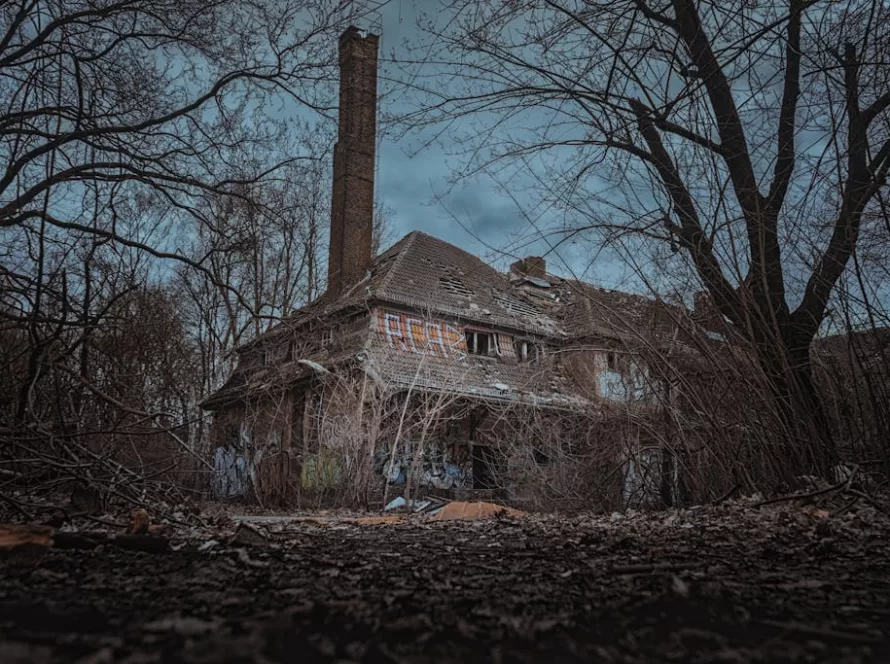
Edgar Allan Poe Usher Family
Welcome to the haunting world of Edgar Allan Poe House of Usher. Where darkness seeps through the cracks, and the shadows hold secrets that refuse to stay buried. Step inside this Gothic mansion and prepare to be gripped by the chilling tale that lies within its decaying walls.
In this article, we will delve deep into the depths of Poe’s masterpiece. Uncovering the dark secrets that permeate the House of Usher. We will explore the haunting atmosphere. The enigmatic characters and the psychological horrors have fascinated readers for generations.
Edgar Allan Poe is known for his macabre storytelling. Takes us on a journey through the unraveling mind of the Usher family. As the story unfolds, we witness the gradual descent into madness—the crumbling of reality, and an eerie connection between the house and its inhabitants.
Join us as we navigate the twisted corridors of the House of Usher. Peeling back its layers of mystery and unveiling the sinister forces that lurk within. Prepare to be enthralled, disturbed, and left questioning your sanity as we explore the dark. The dark world of Edgar Allan Poe’s House of Usher.
Brief biography of Edgar Allan Poe
Edgar Allan Poe was born on January 19, 1809, in Boston, Massachusetts. Was a famous American writer and poet. Poe’s life was marked by tragedy, loss, and a deep fascination with the macabre. His works, including “The Fall of the House of Usher.” Has had a profound impact on the horror and Gothic genres.
Poe’s troubled childhood was marked by the death of his parents and the subsequent separation from his siblings. Played a significant role in shaping his dark and melancholic writing style. Throughout his tumultuous life, Poe battled poverty, addiction, and personal demons. Which ultimately led to his untimely death in 1849.
Despite his struggles, Poe’s literary contributions remain influential. And continue to thrill readers with their exploration of the human psyche and the darker aspects of human nature.
The inspiration behind “The Fall of the Edgar Allan Poe House of Usher
“The Fall of the House of Usher” was published in 1839 and is considered one of Poe’s most famous works. The story revolves around the narrator’s visit to the decaying House of Usher. He becomes a witness to its inhabitants’ psychological and physical decline. Roderick and Madeline Usher.
Poe drew inspiration for the House of Usher from various sources. Including his own experiences and the Gothic tradition. Prevalent in literature during the 18th and 19th centuries. The crumbling mansion serves as a metaphor for the deteriorating mind and soul of the Usher family. Mirroring the decay and disintegration of their sanity.
Additionally, Poe’s fascination with architecture and the supernatural played a significant role in shaping the eerie atmosphere. Haunting imagery is present throughout the story. “The Fall of the House of Usher” is a testament to Poe’s ability to create a sense of dread and unease. Leaving readers on the edge of their seats.
Analysis of the Gothic elements in the story
“The Fall of the House of Usher” is a quintessential example of Gothic literature. Incorporating various elements that contribute to its dark and foreboding atmosphere. Poe masterfully weaves together these elements to create a sense of impending doom and lingering dread.
One of the key Gothic elements present in the story is the setting itself, the House of Usher. The mansion is described as a decaying and desolate place. Surrounded by a bleak and desolate landscape. Its dilapidated state serves as a reflection of the Usher family’s deteriorating mental and physical health. Heightening the sense of gloom and impending tragedy.
The use of symbolism is another crucial aspect of the Gothic tradition within the story. The Usher family lineage, represented by the crumbling house, symbolizes the decay and decline of both the physical and mental states of its inhabitants. The family’s dark secrets and hidden sins are metaphorically trapped within the walls of the mansion, haunting them and ultimately leading to their downfall.
Poe also employs the supernatural as a Gothic element, blurring the lines between reality and the supernatural realm. The character of Madeline Usher, who is believed to be dead but later returns, embodies this supernatural presence. Her reappearance adds to the sense of horror and the unknown, leaving readers questioning the boundaries between life and death.
The symbolism in “The Fall of the Edgar Allan Poe House of Usher
“The Fall of the Edgar Allan Poe House of Usher” is rich in symbolism, with each element serving a deeper purpose within the narrative. Poe utilizes symbolism to enhance the story’s themes of decay, madness, and the destructive power of the past.
The House of Usher itself symbolizes the deteriorating state of the Usher family. The decaying mansion represents the crumbling mental and physical health of its inhabitants, reflecting their isolation and despair. The house acts as a physical manifestation of their troubled minds, with its dark and gloomy atmosphere mirroring their inner torment.
The tarn, a stagnant body of water surrounding the mansion, symbolizes the stagnant and melancholic state of the Usher family’s existence. It represents the suffocating weight of their past sins and the inability to escape the consequences of their actions.
The character of Roderick Usher symbolizes the fragility of the human psyche. His increasingly erratic behavior and obsession with death and decay illustrate the destructive power of unresolved trauma and repressed emotions. Roderick’s descent into madness mirrors the crumbling state of the house and serves as a warning against the dangers of burying one’s inner demons.
The psychological themes explored in the story
“The Fall of the House of Usher” delves into various psychological themes, reflecting Poe’s deep understanding of the human mind and its complexities. The story explores themes of mental illness, the power of the subconscious, and the influence of the past on the present.
One of the central psychological themes in the story is the power of the subconscious mind. Poe depicts the characters’ subconscious desires and fears, which manifest in their dreams and visions. These manifestations blur the line between reality and illusion, highlighting the intricacies and mysteries of the human psyche.
The theme of inherited mental illness is also prevalent in the story. The Usher family’s history of madness and the narrator’s observation of Roderick’s deteriorating mental state suggests a hereditary component to their affliction. This exploration of mental illness adds depth to the story and raises questions about the potential influence of one’s ancestry on their mental well-being.
Furthermore, Poe explores the impact of past traumas on the present. The Usher family’s dark secrets and hidden sins weigh heavily on their psyches, contributing to their mental and physical decline. The inability to confront and resolve these past traumas ultimately leads to their tragic downfall, highlighting the destructive power of unresolved guilt and shame.
The eerie atmosphere of the House of Usher
The House of Usher is shrouded in an eerie atmosphere that permeates the entire story. Poe’s masterful use of descriptive language and vivid imagery creates a sense of unease and impending doom.
The physical description of the mansion contributes to its eerie ambiance. The crumbling walls, the decaying furniture, and the oppressive silence all contribute to a feeling of decay and desolation. The house becomes a character in itself, exerting a malevolent presence that haunts both the characters and the readers.
Poe’s use of sensory details further heightens the atmosphere of dread. The constant references to darkness, shadows, and the grotesque create a sense of foreboding. The recurring motif of the storm outside mirrors the turmoil within the characters’ minds, intensifying the already tense atmosphere.
Additionally, the use of sounds and music plays a significant role in creating an eerie ambiance. The narrator describes the haunting melodies played by Roderick on his guitar, which add to the overall sense of unease and contribute to the disintegration of reality. These auditory elements immerse the readers in the unsettling world of the House of Usher, leaving them on edge throughout the story.
The impact of “The Fall of the House of Usher” on literature and culture
“The Fall of the House of Usher“ has had a profound impact on literature and popular culture since its publication. Poe’s unique blend of horror, psychological exploration, and Gothic elements has influenced countless writers and filmmakers over the years.
The story’s exploration of the human psyche and its examination of the darker aspects of human nature laid the foundation for the development of psychological horror as a subgenre. Writers such as H.P. Lovecraft, Stephen King, and Clive Barker have cited Poe as a significant influence on their works, further solidifying his legacy in the horror genre.
Furthermore, “The Fall of the House of Usher” has inspired numerous adaptations in various forms of media, including film, theater, and music. Filmmakers such as Roger Corman and Jean Epstein have brought the story to life on the silver screen, capturing the eerie atmosphere and psychological themes present in the original text.
The enduring popularity of “The Fall of the House of Usher” speaks to its timeless appeal and its ability to resonate with audiences across generations. Poe’s exploration of human nature, the power of the subconscious, and the lingering effects of the past continue to captivate readers and serve as a testament to his literary genius.
Visiting Edgar Allan Poe’s House of Usher today
While the House of Usher exists solely within the realm of fiction, fans of Edgar Allan Poe can still visit places associated with the author and his works. One such place is the Edgar Allan Poe House and Museum in Baltimore, Maryland.
The Edgar Allan Poe House and Museum is the former residence of the author during his time in Baltimore. The museum showcases artifacts, exhibits, and memorabilia related to Poe’s life and works. Visitors can explore the rooms where Poe lived and wrote, gaining insight into the environment that influenced his haunting tales.
Additionally, various cities and towns across the United States, including Boston and Philadelphia, have monuments, statues, and plaques dedicated to Edgar Allan Poe. These landmarks serve as a tribute to the enduring legacy of one of America’s most celebrated literary figures.
For fans of Poe’s work, visiting these locations provides a deeper appreciation for the man behind the macabre stories and a connection to the haunting worlds he created.
Conclusion: The enduring legacy of Edgar Allan Poe’s House of Usher
Edgar Allan Poe’s House of Usher continues to captivate readers with its haunting atmosphere, enigmatic characters, and psychological horrors. The story’s exploration of decay, madness, and the destructive power of the past resonates with audiences across generations, solidifying its place in the Gothic literary canon.
Poe’s ability to create a sense of dread and unease through vivid imagery and masterful storytelling showcases his unparalleled talent as a writer. “The Fall of the House of Usher” remains a testament to his enduring legacy and continues to inspire and influence countless artists in the fields of literature, film, and music.
So, step into the House of Usher, immerse yourself in its chilling tale, and uncover the dark secrets that lie within. But be warned, once you enter this Gothic mansion, you may never escape its haunting grip.












































































































